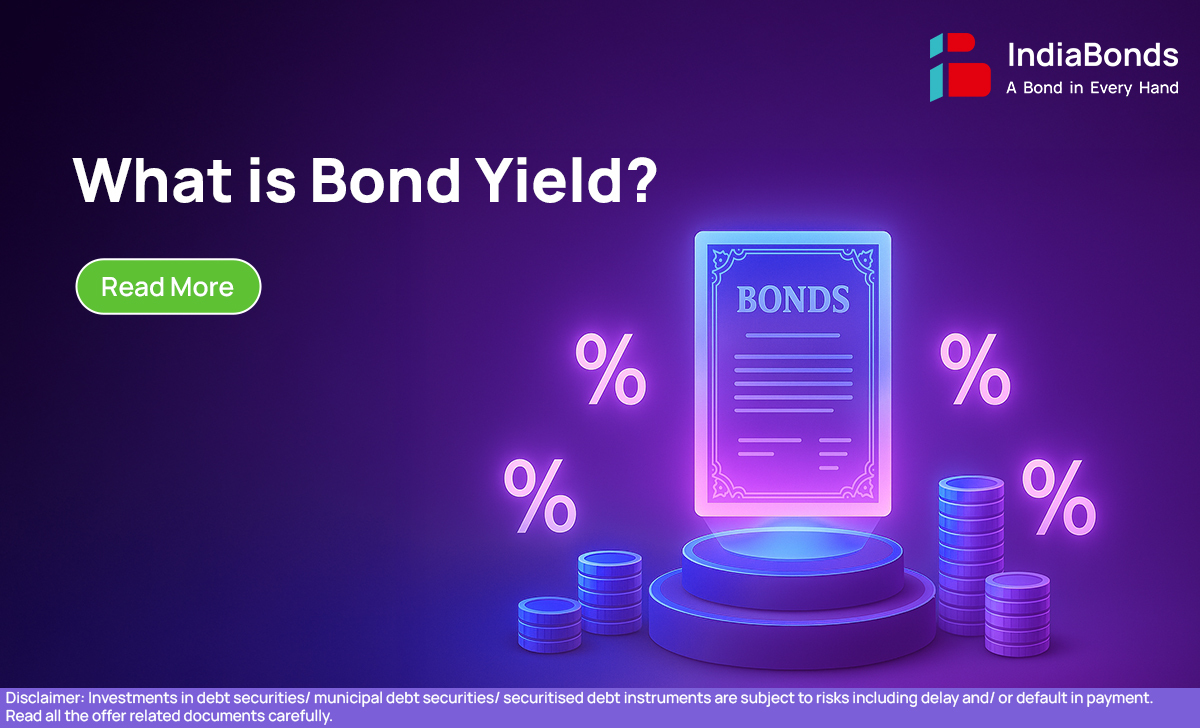What is Bond Yield?

Every investor wants to know one thing before putting money into a bond: “What will I actually get back?” That answer lies in Bond Yield. It’s not just a technical ratio but a real-world measure of what your investment earns compared to what you pay for it.
What Is a Bond Yield?
Let’s get straight to it — what is Bond Yield? At its core, it’s the return you earn from a bond. The Bond Yield meaning is tied to two elements: the fixed coupon payment and the price you pay in the market. If the bond gets cheaper, the yield goes up; if it becomes pricier, the yield goes down. Investors often use the bond yield definition as a quick guide to compare bonds with different coupons or prices. It’s the simplest way of judging a bond’s worth.
Understanding Bond Yields
Think of Bond Yield as the voice of the bond market. A high yield is like a loud whisper saying, “I’ll give you more income, but trade carefully — risk is higher.” A low yield, on the other hand, says, “I’ll keep you at a low risk, but don’t expect big returns.” In India, a G-Sec might yield less but offer security backed by the government, while an NBFC bond could yield more but comes with extra credit risk. Reading yields this way helps investors decide what fits their needs.




Formula and Calculation of a Bond Yield
Here’s the math in its simplest form:
Current Yield=Annual Coupon Market Price\text{Current Yield} = \frac{\text{Annual Coupon}}{\text{Market Price}}Current Yield=Market Price Annual Coupon Say a bond pays ₹700 annually. If it trades at ₹14,000, the yield is 5%. This quick formula works for a snapshot. But in practice, investors also look at yield-to-maturity (YTM), which considers time to maturity, reinvested coupons, and redemption value. YTM tells the full story of what a bond might actually return if held till the end.
Yield vs. Price
The dance between price and Bond Yield is fascinating. They move in opposite directions — like a seesaw.
Take this case: a bond has a face value of ₹1,000 and pays ₹80 annually. At par, its yield is 8%. But what if you buy it for ₹900? Your yield jumps above 8%. Now flip it. If market demand pushes the price to ₹1,100, your effective yield dips below 8%.
This push-and-pull happens because while the coupon stays the same, the price you pay changes how attractive the bond looks. When interest rates rise, new bonds come with better coupons, so older bonds lose value — their prices drop and yields climb. When rates fall, investors chase older higher-paying bonds, pushing prices up and yields down.
In India, we’ve seen this play out in recent years. RBI rate hikes pushed yields higher, making PSU and corporate bonds more rewarding. On the flip side, during uncertain times, G-Secs became hot picks, their prices rose, and yields dropped.
Additional Calculations
The current yield is handy but often incomplete. Investors use several other ways to measure Bond Yield:
- Yield to Maturity (YTM):
YTM is the complete picture. It considers coupon payments, time to maturity, and price at redemption. If you buy an SBI bond at a discount and hold it to maturity, YTM shows the annual return you’ll truly earn. - Yield to Call (YTC):
Some bonds, especially NBFC or housing finance bonds, come with call features. The issuer can redeem them early when interest rates drop. YTC helps estimate returns if that happens. - Yield to Worst (YTW):
A cautious measure. It calculates the lowest yield possible under any scenario, including early calls. Think of it as the “worst-case income” you can expect. - Nominal vs. Real Yield:
Nominal yield is what’s printed on the bond (say 7%). Real yield factors in inflation. If inflation is 5%, your real return is closer to 2%. - Running Yield:
Useful for secondary market buyers. It calculates returns based on the bond’s market price today, not the original issue price.
Each calculation has its role. For example, a retail investor may look at running yield to judge immediate income potential, while an institution may rely on YTM for long-term planning. The point is — a single number doesn’t cut it. Smart investing means checking multiple yield metrics before deciding.
Calculation Issues
Here’s the tricky part: Bond Yield calculations look neat on paper, but reality adds wrinkles.
For one, most formulas assume you can reinvest coupon payments at the same rate. But who can guarantee that? If market rates drop, your reinvested money may earn less, dragging down overall returns.
Another gap is costs. Taxes, brokerage, and transaction charges often reduce what you finally take home. For Indian investors, even the settlement timeline matters.
Then there’s inflation. A bond may show 6% yield, but if inflation runs at 6% too, your real return is basically zero.
Finally, bond prices move daily. A yield you calculate today could shift tomorrow if RBI announces a policy change or if the issuer’s credit rating is altered. In short, yields are helpful guides but not foolproof promises. They need context.
Conclusion
Bond Yield is the backbone of fixed-income investing. It tells you how much return to expect, whether the bond is overpriced, and what risks might lurk behind attractive numbers. By learning how to read yields, compare calculations, and factor in real-world issues, investors can make better calls. At the end of the day, yield is not just about numbers — it’s about understanding the bond’s story.
FAQs
Q1. What does a Bond’s Yield tell investors?
It shows the return relative to the bond’s price, helping assess both income and risk.
Q2. Are high-yield bonds better investments than low-yield bonds?
Not always. High yields often come with higher default risk, while lower yields usually point to safety and stability.
Q3. Are high-yield bonds the same as junk bonds?
Yes, in most cases. Junk bonds are essentially high-yield bonds with lower credit ratings.
Q4. How do investors utilize bond yields?
Investors use yields to compare different bonds, balance risk with return, and decide when to buy or sell.
Disclaimer : Investments in debt securities/ municipal debt securities/ securitised debt instruments are subject to risks including delay and/ or default in payment. Read all the offer related documents carefully.



















































